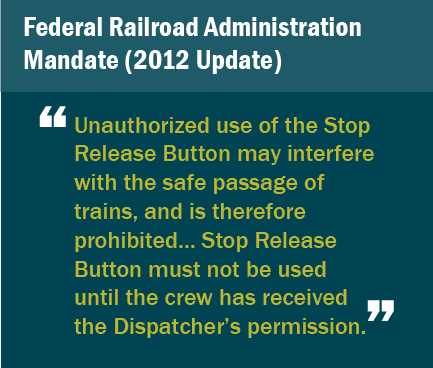Amtrak Rolls Out Secure Positive Train Stop Release Controls
Amtrak is introducing a multi-step authentication system to prevent train crews from overriding stop signals without dispatcher approval. The new safety improvements build upon the success of positive train control (PTC) technology.
Secure Positive Train Stop Release (PTSR) creates an additional layer of safety to prevent locomotives from occupying main tracks without proper authority, thereby avoiding potential accidents.
Over time, all other Northeast Corridor rail operators are expected to implement Secure PTSR.
Accident Risks Prompt New Safety Rules
Secure PTSR was born out of the U.S. Federal Railroad Administration’s realization that train crews could potentially misread rail signals and mistakenly initiate a Positive Train Stop (PTS) override. If a crew incorrectly believe their train has permission to proceed, releasing the PTC-applied brakes without first confirming with the dispatch center, this could result in risk of a potential collision or derailment within an interlocking.
FRA recently modified the Advanced Civil Speed Enforcement System (ACSES) requirements. Dispatcher confirmation is now necessary when using the Stop Release Button to override PTC enforcement of a Stop Signal. Using a multi-step authentication system, engineers who do not receive explicit permission from a dispatch center will not be able to independently override the Stop Signal enforcement. The Secure PTSR functionality will apply in situations of signal-system failure or operational anomalies.

Amtrak has implemented Secure PTSR across its Northeast Corridor ACSES rail operation centers and has begun deploying the solution across its ACSES-equipped fleets. Regional operators will be next in line. FRA requirements state that ACSES users must have a Secure PTSR implementation schedule in place within 90 days of Amtrak completing Secure PTSR activation across all of Amtrak’s ACSES-equipped lines. Amtrak activated its final line on September 17, 2024.

How Secure PTSR Works
Moving forward, when a train needs to pass a Stop Signal enforced by PTC, locomotive engineers will receive verbal permission from the train dispatcher via the two-way voice radio system. Permission is based upon:
- Location of the train
- Direction of travel
- Route to be used
- Locomotive identification number
After the engineer repeats the permission correctly, the dispatcher will generate a unique, four-digit, single-use passcode from the Secure PTSR Code Manager, which is interfaced with the dispatcher’s computer-aided dispatch (CAD) console. The system’s algorithm generates a code unique for each engine and time of day.
At this point, the dispatch center’s code manager and the train’s on-board computer will produce identical codes. After the dispatcher provides the code to the engineer, the code is entered onto a newly installed Secure PTSR keypad. Secure release is only authorized when the code input onto the keypad matches the code generated by the on-board computer.
Newer Technology Meets Older Trains
An initial challenge was determining how to adapt Secure PTSR hardware for existing Amtrak trainsets — the Amtrak fleet consists of 13 different types of locomotives. Integrating the 4.25-by-6.25-inch keypads and a new on-board computer required assessing multiple installation design options. Keypad placements vary by application; older trains are especially space constrained.
So far, Amtrak has completed updates to all their ACSES-equipped dispatch centers and performed modifications to their fleet of locomotives with new code-generating equipment.
The next challenge involved the testing of Secure PTSR functionality — all without disrupting daily Amtrak operations. Testing procedures had to ensure Secure PTSR’s on-board equipment, dispatch equipment, and Amtrak’s supporting database could overlay with existing PTC systems, achieving seamless interoperability.
Secure PTSR implementation was designed to be incremental. Across Amtrak territories, rollout occurred on a line-by-line and vehicle-by-vehicle basis. Other host railroads will follow suit by implementing Secure PTSR on their respective territories and then ensuring all vehicles are equipped. Tenant vehicles operating in ACSES territory will also require the technology to be equipped on their fleets, coordinating the needs with their respective host railroads.
Eventually, Secure PTSR will operate across all ACSES-equipped mainline tracks on the Northeast Corridor. Dispatch offices from across the region’s territories will need to be equipped and trained.
Amtrak’s Commitment to Safety
With Secure PTSR, Amtrak is taking proactive measures to uphold strict safety precautions. The multi-step authentication system recognizes that human errors and system failures do happen. Secure PTSR implementation will prevent situations of unauthorized manual PTC override, while granting engineers critical levels of flexibility such as during circuit problems or other system disruptions.
Secure PTSR will ensure rail remains one of the safest methods of travel. Combined with other Amtrak safety advancements, accidents will continue to be increasingly rare.
Featured photo credit: “Crossing the Susquehanna”, by bobrossplush, CC BY 2.0, via Flickr


